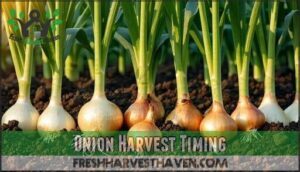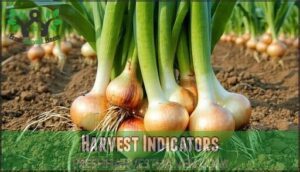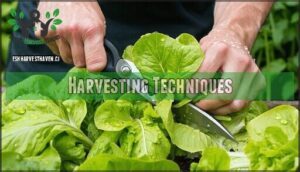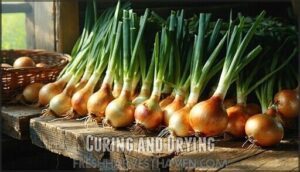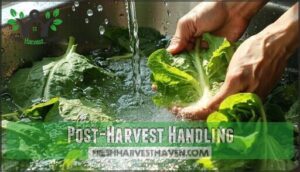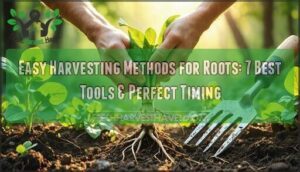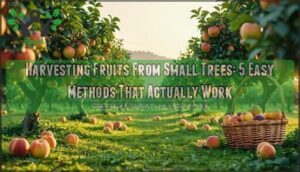This site is supported by our readers. We may earn a commission, at no cost to you, if you purchase through links.
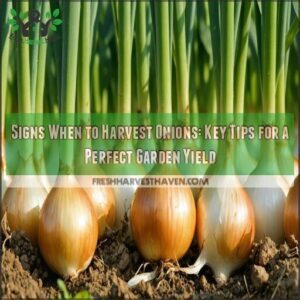 The best signs when to harvest onions start with the tops. Once most of the green foliage flops over and begins drying, that’s your cue.
The best signs when to harvest onions start with the tops. Once most of the green foliage flops over and begins drying, that’s your cue.
Gently test the necks—if they’re soft and no longer firm, the bulb has finished storing energy. You’ll also notice the outer layers becoming papery and dry, like onions in the store.
Harvest on a sunny morning to keep bulbs dry, and handle them gently to avoid bruising.
Timing is key; leave them too long, and they might sprout. Think of it like catching a perfect wave—too early or too late, and you’ll miss the sweet spot.
Table Of Contents
- Key Takeaways
- Onion Harvest Timing
- Harvest Indicators
- Harvesting Techniques
- Curing and Drying
- Post-Harvest Handling
- Frequently Asked Questions (FAQs)
- How do I know when my onions are ready to pick?
- How long can I leave onions in the ground?
- How do you know when onions are done curing?
- What do onions look like when they are done growing?
- What are the benefits of harvesting onions early?
- How can weather forecasts impact onion harvest timing?
- Can digging onions too early stop growth?
- When should onions be mulched or covered after harvest?
- What are the consequences of leaving bulbs exposed?
- Conclusion
Key Takeaways
- Wait until the onion tops flop over, dry out, and turn brown; that’s your signal they’re ready to harvest.
- Check the necks—they should feel dry and tight, not soft or fleshy, indicating full maturity.
- Harvest on a sunny morning and handle the bulbs gently to avoid bruising and ensure better storage.
- Don’t leave onions in the ground for more than two weeks after the tops dry and fall over to prevent rot.
Onion Harvest Timing
You’ll know it’s time to harvest your onions when their tops start falling over, turning brown and dry.
When onion tops flop and turn dry, it’s nature’s nudge—time to pull them for peak flavor and long-lasting freshness!
Pay attention to their necks too—if they feel tight and no longer fleshy, your onions are ready to leave the soil.
Tops Falling Over
Tops falling over is a key onion maturity sign—your signal to start planning the harvest.
Look for these indicators:
- Toppling Percentage: Wait until 50-80% of tops flop.
- Soft Necks: Verify firmness, as floppy ones suggest readiness.
- Harvest Window: Pull within two weeks of toppling.
- Varietal Differences: Short-day onions mature faster.
Timing is everything in onion top dieback! Harvesting at the 80% dry harvest window is ideal.
Neck Turning Dry
A dry neck is your go-to signal for onion maturity. When necks shift from green and fleshy to dry and tight, it’s time.
A dry, tight neck signals perfect onion maturity—time to harvest and enjoy long-lasting, flavorful bulbs.
Moist necks risk rot; dryness guarantees long-term storage.
Varieties differ in neck thickness, so check for tightness by rolling layers.
Don’t delay, as overripe onions weaken.
Here’s a quick comparison:
| Indicator | Immature Neck | Mature Neck | Overripe Neck |
|---|---|---|---|
| Moisture Content | High | Low | Very Low |
| Texture | Fleshy | Tight | Withered |
| Harvesting Impact | Premature | Ideal | Riskier Rot |
| Rot Risk | Increased | Minimized | Significant |
This signal is critical because it directly affects the harvesting impact and rot risk associated with the onions.
Foliage Drying Out
When you notice at least 50-80% of the foliage turning brown and drying out, it’s a clear sign your onions are maturing.
The drying foliage, influenced by climate and varietal differences, signals the start of the harvest window.
Acting promptly prevents rot and guarantees quality. Keep an eye on these onion harvest signs for the best results.
Soft or Withered Necks
Soft or withered necks are a clear sign onions are overripe and past their prime.
Harvesting delay affects storage impact, so act quickly.
Here’s what to check:
- Neck softness signals final maturity.
- Withered necks mean carbohydrates stopped transferring.
- Onion neck fall indicates readiness.
- Overripe onions may rot if left longer.
- Timely onion harvesting guarantees better storage.
Harvest Indicators
You can tell onions are ready to harvest when their tops flop over, the outer layers dry, and the necks feel tight and firm.
These signs show the bulbs have stopped growing and are storing energy, making them perfect for picking, as they indicate the onions have reached a state where they are ready to be harvested.
Flopping Tops
When about 80% of your onions’ tops flop over, it’s a clear sign they’re ready.
This “topping percentage” signals onion maturity. A complete softneck means the harvest window is open.
Be mindful—variety influence and environmental factors like wind can play tricks, so monitor onion neck fall closely.
Don’t delay too long, or you’ll risk diminishing flavor and storage quality!
Dry Outer Layers
When onion tops start flopping, take a closer look at the outer layers.
Mature onions form papery skins, a key sign of harvest readiness. These dry, protective layers prevent rot, enhance color, and indicate storage readiness.
If outer layers feel brittle yet intact, you’ve hit the sweet spot for curing duration and maximizing shelf life.
Perfect timing boosts onion maturity signs!
Firm Fluid-Filled Necks
When evaluating onion maturity signs, check the neck. A firm, fluid-filled neck means the bulb’s still growing and needs more time.
Immature harvest leads to soft onions that rot. For proper onion harvesting signs, track neck development carefully.
Avoid watering heavily late in growth—it impacts maturity. Remember these key indicators:
- Firm necks
- Full bulbs
- Minimal leaf collapse
- Stable fluid content
The key to successful onion harvesting is understanding the signs of maturity.
Carbohydrate Transfer
During onion maturity, leaf carbohydrates move to the bulb, fueling development and flavor intensity.
A soft neck signals this carbohydrate transfer is complete, indicating onion harvest readiness.
The sugars enhance bulb size while impacting storage implications and taste.
Delaying harvest risks bulb rot, so watch closely—balanced timing guarantees the perfect blend of sweetness, sharpness, and storage longevity.
Onions can lose a substantial amount of weight, impacting their culinary use, during ambient temperature storage.
Harvesting Techniques
When it’s time to harvest onions, you’ll want to use proper techniques to guarantee the bulbs stay intact and fresh.
Whether you’re pulling them by the tops or loosening the soil with a garden fork, handle them gently to avoid bruising, and remember to always handle them with care.
Pulling by Foliage
When soil softness allows, use foliage strength to pull onions gently, avoiding snapping or root damage.
Verify onion maturity indicators, like top fall and leaf bending, signal readiness. Onion neck withering means it’s time to act.
Always handle with care—aggressive pulling can bruise bulbs.
- Pull by tops when leaves are dry.
- Avoid yanking too hard.
- Check for neck flexibility.
- Act before overripe to prevent damage and ensure the best results for your onion harvest.
Using Garden Fork
Sometimes, soil feels stubborn, making a garden fork your best friend. Aim the fork at a shallow angle—too deep, and you risk damaging the bulbs.
Loosen soil gently to prevent tearing. Protect onion bulb size by working around their edges, not under them. Choose sturdy tools for better control, ensuring onion maturity indicators like toppled tops remain intact.
Consider using a specialized harvesting fork tool for efficiency.
| Technique | Benefit | Risk | Tip |
|---|---|---|---|
| Fork Angle | Prevents bulb damage | Over-penetration | Aim shallowly, avoid roots |
| Soil Loosening | Eases pulling | Bruising bulbs | Loosen gently around edges |
| Depth Control | Protects bulb size | Harming bulbs | Work just below surface |
| Tool Selection | Enhances precision | Poor grip | Use a sturdy garden fork |
Avoiding Bruising
Handling onions gently is essential during their harvest time, especially for mature onions.
Use proper tools like soft brushes to clean dirt carefully, avoiding bruises that shorten storage life and impact bulb maturity.
Careful harvesting preserves onion bulb size and quality.
Remember, improper handling at onion harvesting can lead to rot later.
Treat onions like delicate treasures—they’ll reward you with longer freshness!
Using clean tools helps, as harvesting garden tools prevent damage to ensure proper handling and maintain the onion’s quality.
Morning Harvest
Start harvesting onions in the cool morning hours. It’s the best time to avoid heat stress while preserving the bulbs’ quality. Without the harsh midday sun, onions stay firm and easier to handle.
- Prevent bolting onions by timing the harvest properly.
- Morning harvest aids respiration for storage longevity.
- Aim for ideal tenderness in mature onions.
- Avoid direct sunlight to reduce damage risk, ensuring the onions remain in good condition for storage and use, thus maintaining their quality.
Curing and Drying
After harvesting, curing and drying your onions properly is essential to keep them from rotting.
By ensuring good airflow and moderate temperatures, you’ll extend their shelf life and preserve their flavor.
Indoor Curing
Curing onions indoors requires proper ventilation and moderate temperature control, ideally between 75-90°F.
Keep humidity levels low to avoid mold and make certain the necks dry fully. Space requirements are vital—don’t overcrowd onions to allow airflow.
Use screens or mesh trays for even drying. Consider specialized onion screens for ideal airflow. Effective onion curing prevents spoilage and boosts onion storage, making them last for months.
Outdoor Drying
After the onion harvest time, let them dry outside for a few days.
Choose a flat, shaded drying surface to protect from sunlight exposure.
Good airflow importance can’t be overstated—space them out to prevent rot.
Consider using an onion drying solution for superior results.
Watch the weather; rain or humidity risks spoilage.
For pest protection, avoid ground contact.
Drying onions properly guarantees longer storage.
Ideal Conditions
Once your onions show maturity—like top fall indicators—focus on drying in dry weather.
Moderate temperatures and steady airflow are your allies. Humidity monitoring is key to avoiding spoilage, while shade benefits onions by preventing sunburn.
One method to keep in mind is using mulch and wind protection to create stable microclimates.
Make certain stable conditions during this onion harvest time to preserve their quality. Proper drying enhances flavor and lifespan, making them storage-ready, and is crucial for onion harvest and maintaining quality.
Proper Spacing
Proper spacing is critical for onions during curing to guarantee ideal airflow needs and bulb size preservation.
Without room to breathe, moisture can linger, inviting disease and stunting onion maturity.
Spread them in single layers—clumped bulbs lead to competition and uneven drying.
Think of this step as giving each bulb its personal space to shine while promoting proper onion growth and ensuring ideal airflow for bulb size preservation.
Post-Harvest Handling
After harvesting your onions, you’ll need to sort and store them properly to keep them fresh for months.
Focus on maintaining the right temperature, humidity, and regular checks to prevent spoilage.
Sorting Defective Onions
When sorting onions post-harvest, toss out any sprouted onions or bruised bulbs—they’re trouble waiting to happen.
Follow these steps for rot prevention and better storage:
- Remove damaged bulbs or those with thick necks.
- Discard onions showing early signs of rot.
- Separate sprouted onions for immediate use.
- Protect your good onions from rot by keeping defects away.
Storage Temperature
After sorting, it’s all about maintaining the right onion storage temperature. Aim for 32-40°F to keep your harvest fresh for months.
Avoid sharp temperature fluctuations, as they shorten shelf life. Gradual cooling after onion bulb maturity prevents shock.
Stay above the freezing point to avoid damage—think “not too hot, not too cold,” like Goldilocks’ porridge.
For optimal longevity, make certain you provide a cool, dark place with the best conditions to ensure your onions last.
Humidity Control
Balancing onion storage humidity is like controlling a seesaw—too much moisture encourages mold, while too little dries them out.
Aim for 65%-70% humidity with good air circulation. Use indoor drying for damp harvests to avoid spoilage risks.
Temperature monitoring helps manage onion respiration, keeping bulbs firm. Prevent mold with proper onion drying conditions and keep moisture levels in check, ensuring good air circulation and maintaining 65%-70% humidity to prevent mold.
Regular Inspection
After managing humidity, make timely checks to maintain storage longevity.
Look for spoilage signs like soft spots or sprouting to guarantee rot prevention. Regular inspection is quality control for your hard-earned harvest.
Think of it as babysitting your onions, ensuring they thrive post-harvest. Staying alert helps you enjoy perfectly stored bulbs long after onion top fall indicators and bulb maturity stages, which is crucial for perfectly stored bulbs.
Frequently Asked Questions (FAQs)
How do I know when my onions are ready to pick?
When onion tops look like they’ve surrendered after a long fight—dried, brown, and fallen over—it’s time.
Check for tight, dry necks and avoid soft, withered ones.
Harvest within two weeks to prevent rot.
How long can I leave onions in the ground?
You shouldn’t leave onions in the ground longer than two weeks after most tops dry and fall over.
Waiting too long increases the risk of rot, especially in wet soil or humid conditions.
How do you know when onions are done curing?
When the onions’ necks feel tight, and the outer skin turns dry and papery like an antique book, they’re done curing.
Check for zero moisture or softness, and store them in a cool, dry spot.
What do onions look like when they are done growing?
When they’re done growing, their tops turn yellow, flop over, and dry out.
The necks tighten, feel dry, and leaves stop feeding the bulbs.
Pull a test onion—it should be firm with papery skin.
What are the benefits of harvesting onions early?
Grabbing onions a bit early lets you enjoy milder flavors, fresher textures, and more tender bulbs.
Plus, it reduces storage worries since they’ll spoil less from over-drying or rot.
It’s like catching them mid-performance, which can be a complete experience.
How can weather forecasts impact onion harvest timing?
Dodging downpours and steamy forecasts, you’ll want to harvest onions under dry, breezy conditions.
Wet weather risks rot, while high humidity hinders curing.
Keep an eye on the forecast—it’s your secret weapon for perfect timing.
Can digging onions too early stop growth?
Pulling onions too early can halt their growth since they haven’t fully matured.
They need time for tops to flop over and necks to dry.
Patience guarantees those bulbs reach their full, flavorful potential, with patience being crucial for the development of the onions.
When should onions be mulched or covered after harvest?
Once your onions are fully cured, cover them with mulch or store them in a well-ventilated, dry area.
This protects them from moisture, rot, and temperature swings, ensuring they stay fresh and flavorful for months.
What are the consequences of leaving bulbs exposed?
Leaving bulbs exposed can cause sunscald, leading to discoloration and soft spots.
It also invites pests and accelerates rot.
Protect onions by curing them properly in shade or indoors to guarantee longer storage life.
Conclusion
Just like reading nature’s clock, spotting the signs when to harvest onions guarantees your hard work pays off.
Watch for tops turning limp, necks softening, and skins drying to papery perfection. Harvesting during a sunny morning keeps the bulbs dry and vibrant, while gentle handling prevents bruising.
Maintaining precise timing keeps onions from sprouting or losing quality. Remember, these steps aren’t just gardening—they’re your recipe for success.
Trust the hints your onions give; they know best, and harvesting during the right time is crucial for success.

